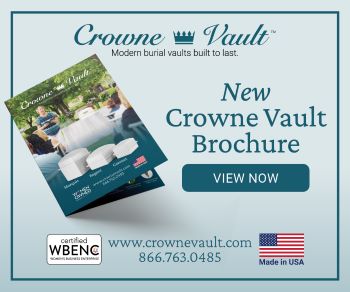Considerations for a crematory
 The Cremation Association of North America (CANA) showed statistics that cremation dispositions in the United States accounted for about 56% of all human dispositions in 2020. I’m guessing that percentage will grow slightly for 2021 as it has every year for the past 40 or so years.
The Cremation Association of North America (CANA) showed statistics that cremation dispositions in the United States accounted for about 56% of all human dispositions in 2020. I’m guessing that percentage will grow slightly for 2021 as it has every year for the past 40 or so years.
CANA’s futuristic looking statistics, which have been pretty accurate over the years, show that at some point in about the next 20 years, barring regulatory issues, cremation will be over 75% of all human dispositions. Those statistics alone would seem to indicate that a funeral home’s investment in a cremation chamber would be a good investment.
From my point of view, the bigger funeral homes have almost all capitalized a project to include their own crematory over the past 20 years. Our funeral home, about 325 calls at the time, did so in 2005. There are, however, a great number of funeral homes in smaller towns in America that do about 100 calls per year. Many of them still transport their cremation cases to a 3rd party trade cremation service. However, I thought I would do a column on the financial aspects of building, owning, and operating your own crematory for a 100 call firm.

Tom Anderson
Funeral Director Daily
I have not bought a crematory since 2005 so for pricing I came upon a current website of one of the manufacturers in North America. Here’s what they said about the cost of purchasing a new crematory: (the company) “normally delivers a Human retort and accessories, installs the equipment, fires the chamber, and trains your cremationists, for approximately $135,000.”
So, let’s use that number and also plug in a number to add a 16 foot by 30 foot addition (480 square feet) to your funeral facility to house and operate your new crematory. At $275 per square foot for construction (I’ve done some recent construction and my guess is the number for your addition would be less than this) for 480 square feet, your addition will cost about $132,000. That brings the project to a total of $267,000.
We will figure your operating costs as such:
- We will pay $40,ooo up front bringing our financing of the project to $227,000
- $227,000 @ 4% on a 20-year amortization results in a $16,500 annual P&I payment
- At 60% cremations (100 call firm) and a $40 per unit fuel cost you have $2,400 in fuel costs.
- Total yearly outlay of $18,900
Now, let’s look at the Margin numbers:
- Whatever you choose to charge, we assume the trade service charges you $350 per case
- If you are doing 60% as above. . . you are paying $21,000 in fees to the trade crematory. That is over $2,000 more than if you did the cremations in house.
If cremations continue to rise in percentage:
- at 70% your outlay, including fuel costs, with your own crematory and fixed financing will be $19,300
- at 70% your outlay using a trade provider will be $24,500. That’s over $5,000 more than if you did the cremations in house.
Other Considerations you need to think about:
- You property insurance may increase with a crematory in house
- As competition rises for cremation, some of it may be price point. Owning your own crematory allows you some leeway on your costs. i.e. if you use a trade crematory, their prices may go up and you cannot control that.
- What value is there to your consumer client families knowing that the funeral home/crematory they called will be conducting all of the aspects of the service without involving a 3rd party? Quite frankly, when I installed a crematory, this was my biggest reason for doing so. Price control mattered, but in-house operation was my number one priority.
- What’s the permitting process in your locale? I scouted this out prior and knew we would need a public hearing. However, in talking to neighbors I knew that there was virtually no opposition to a crematory at our location. In the past 15 years I have seen much, on an international scale, more scrutiny in this area. It’s an area that I now believe a funeral home should know before launching public hearings on a new crematory. Know where you stand because the disagreement and opposition for a new crematory may damage your brand more than the positive aspects of having your own crematory.
- Would you think about adding a pet cremation retort? Many funeral homes have started using pet cremation as an inroads to serve families they have not served in the past. i.e. a customer acquisition method for human services.
- If you have decided to add a crematory. . . . do you go with a flame crematory or go for one of the newer methods such as alkaline hydrolysis or Fireless cremation?
Each funeral home and funeral home owner has to look at the pros and cons of this argument and determine what is right for them. Obviously, as volumes go up, and your fixed financing costs are covered, there is more and more financial benefit to owning your own retort. It’s pretty obvious but many small town funeral directors don’t always think of this. . . . for a growing call funeral home the benefits, in the long run, are greater than for a funeral home declining in calls.
More news from the world of Death Care:
- Would you pay to be “buried” in a Metaverse cemetery? Rolling Stone
- Business owner invests $2.7 million in funeral home project coming to Newport News Southeast community this Spring. Podcast and print article. Daily Press (VA)
- Moody’s affirms Matthews ratings — Outlook Stable. Yahoo Finance.
Enter your e-mail below to join the 2,471 others who receive Funeral Director Daily articles daily:






















Excellent article Tom!
Another consideration when thinking about buying a petrochemical cremation are changes in regulations. Human cremation is currently exempt from regulations applied to similar industrial processes. The below EPA rule has allowed petrochemical cremation to expand without regard to its emissions.
In 2005, “EPA has determined that the human body should not be labeled or considered ‘solid waste.’ Therefore, human crematories are not solid waste combustion units, and are not a subcategory of Other Solid Waste Incineration (OSWI) for regulation.”
When the above regulation is rewritten without the words “not” petrochemical cremation will not be allowed. Re-read the above rule omitting the word not.
Seeing this trend, it makes no sense to purchase a petrochemical crematory system.
The maintenance costs and downtime are additional costs to be factored into owning and operating a crematory.
Further, the exposure to lawsuits from the adverse health effects from emissions need to be weighed. The executives at Ford made a calculated decision regarding the known problem with their Ford Pinto. Crematory operators must make a similar calculated risk, which would certainly exceed the $5,000 or so saved by owning and operating their own crematory. If your state requires testing of mercury and radiation levels in crematory operators, anyone thinking of operating a crematory should take the time to research the reasoning behind these tests.
Excellent article to really look at the costs but think strategically about decisions at the owner/ community level. Best, Kevin